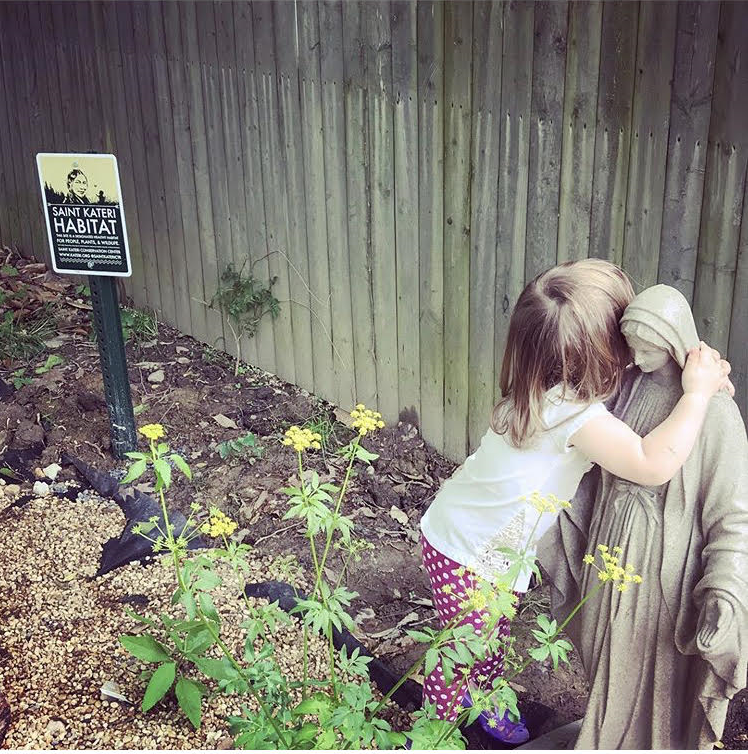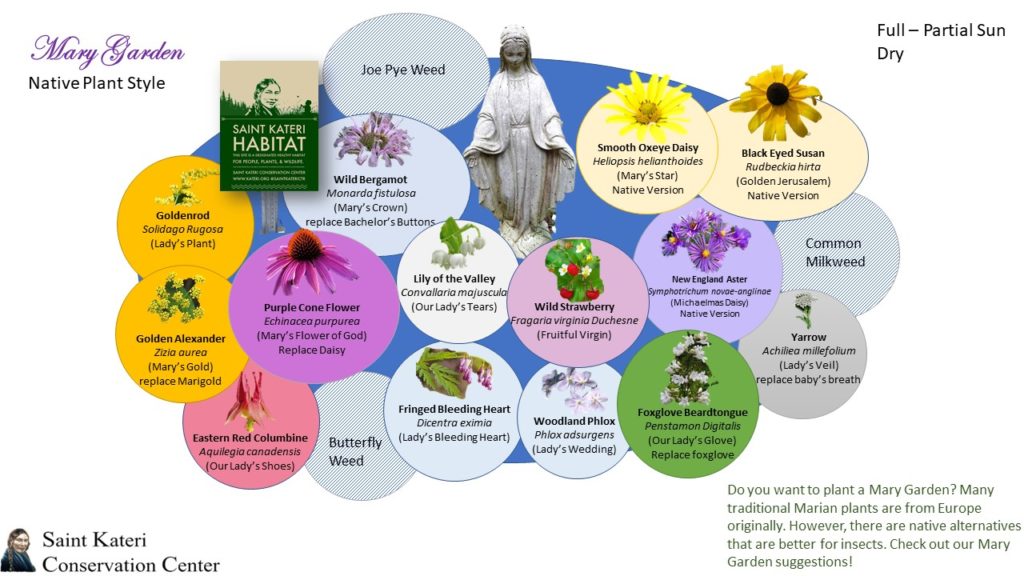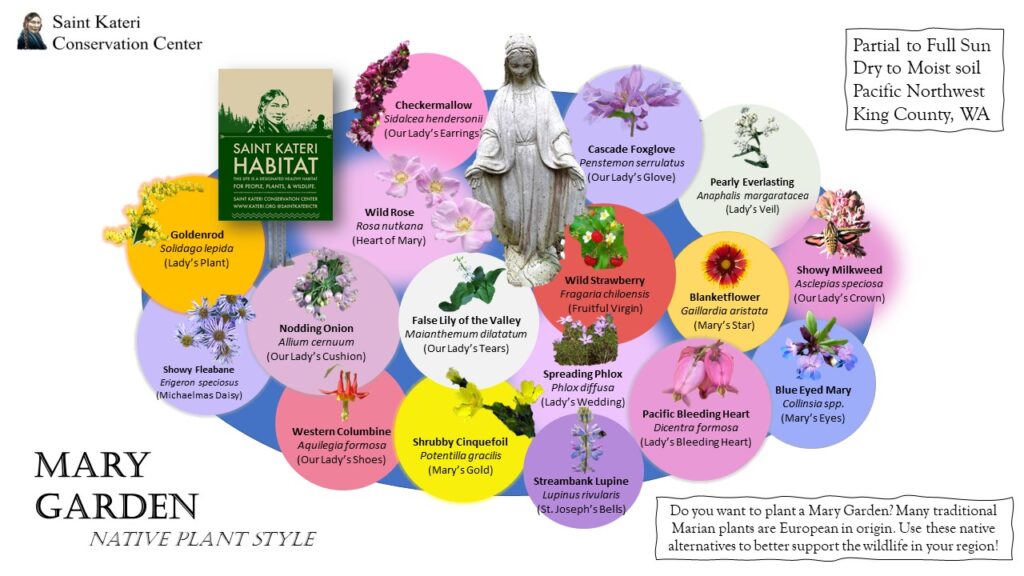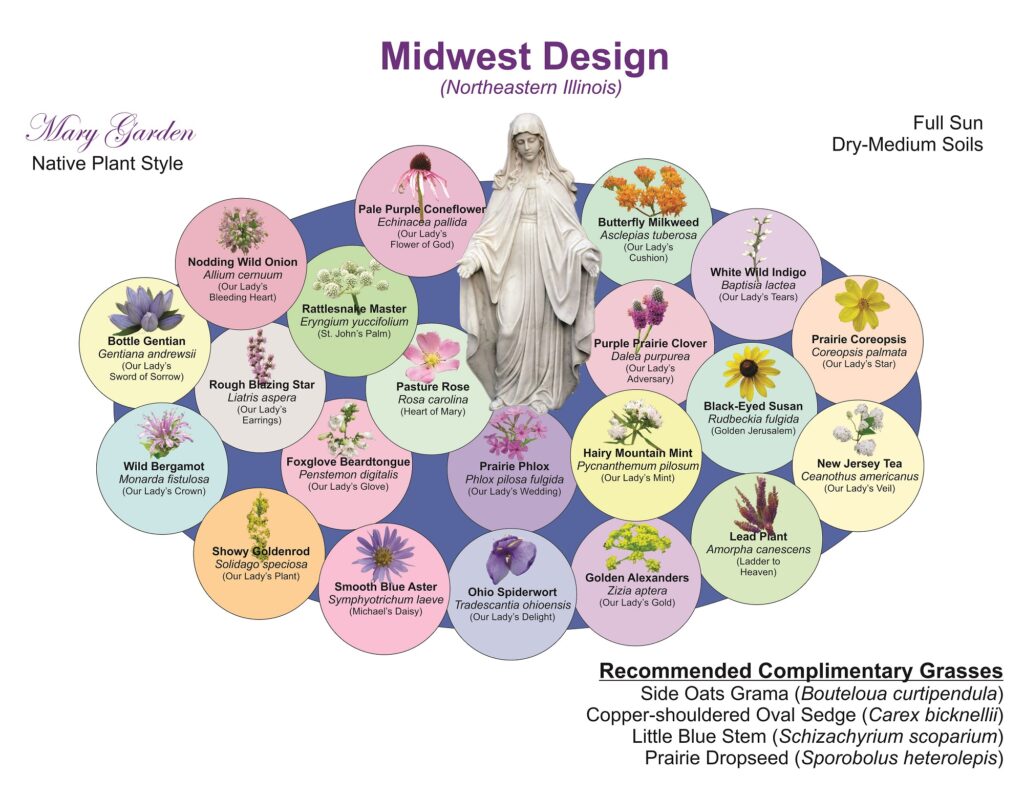Mary Gardens Featuring Native Plants: A Spiritual Experience

History
Creating a Mary Garden has been an activity dating back hundreds of years, originally in Europe. Many plants have legends and symbols associated with them that represent Mary, or some aspect of scripture.
From Mary’s crown visible in many Marian apparitions, to her veil, her gloves, and even her bleeding heart, the possibilities of plants that represent Mary and our Lord are endless.
However, because Mary Gardens originated in Europe, the plants that are described are native to that region, and not in the United States. While some non-native plants do provide food for pollinators, using plants that are native to the United States in a Mary Garden can be both spiritually fulfilling and ecologically beneficial for our Earth and the creatures who dwell in it.
Why Native Plants?
One major threat to the planet is the decline in biodiversity. We, as humans, depend on healthy ecosystems for our survival. This includes clean air to breathe, clean water to drink, and ecosystems that can adapt to a changing climate. We know that the more biodiverse an ecosystem is, the better able it is to provide these ecosystem services.
One of the best ways to help increase biodiversity is to plant native trees and plants on your property, whether that be in your yard, on your Parish or school grounds, or even your apartment balcony. We need to integrate our developed communities with nature. Native plants provide food for pollinators and sequester carbon, as well as increase biodiversity.
Biodiversity and Laudato Si’
Speaking of biodiversity in Laudato si’, Pope Francis said, “The loss of forests and woodlands entails the loss of species which may constitute extremely important resources in the future, not only for food but also for curing disease and other uses. Different species contain genes which could be key resources in years ahead for meeting human needs and regulating environmental problems.”
The Holy Father continued, “It is not enough, however, to think of different species merely as potential ‘resources’ to be exploited, while overlooking the fact that they have value in themselves. Each year sees the disappearance of thousands of plant and animal species which we will never know, which our children will never see, because they have been lost for ever. The great majority become extinct for reasons related to human activity. Because of us, thousands of species will no longer give glory to God by their very existence, nor convey their message to us. We have no such right.”
Thankfully, many of the traditional Mary Garden plants have native alternatives to help preserve biodiversity!
The Saint Kateri Conservation Center has begun a project to identify native alternatives to traditional Mary Garden plants. Below you will see a table of the plants that were chosen. Some of the native plants were chosen because they look similar to the traditional versions. However, some of these plants have the same genus as their European relatives!
Below you will find diagrams of Mary Gardens using native plants native to the East Coast, Pacific Northwest, and the Midwest Regions of the USA
This Mary Garden includes species native to the east coast of the USA, in a site with full to partial sun, that is slightly moist to dry most of the time. You will see the common name of the plant, the symbolic meaning, and the european plant it is replacing. You will also see three plants with no meaning. These are there to show that you can also add other important native alternatives to the garden along with the symbolic plants. Below the diagram, you can see a table of the plants and a link to each to learn more. Native plants are often not sold at your normal department stores! To purchase native plants, you must either visit a native plant nursery, or purchase plants online. The Center has created a Native Plant Nursery Map to help you find your closest nursery! This is the best option, because local ecotype plants are best. But, if you would like to order online, you can visit Prairie Moon.
Please, don’t forget to register your garden as a Saint Kateri Habitat here! You can see all of the registered habitats on our Saint Kateri Habitat Tour Map!
Click right to access our native plant lists for different regions in the US, including the three below and several more!
East Coast Design

Pacific Northwest Design

This Midwestern design was created by regional experts at the request of a parishioner in Northern Illinois. Making a Mary Garden design specific to your ecoregion is a rewarding devotional exercise that helps parishioners learn their local flora!

For two more Mary Garden designs created by our partners at the Marianist Environmental Education Center, visit this link!
